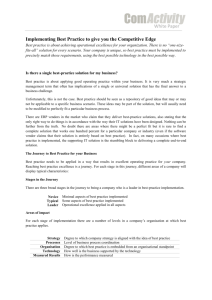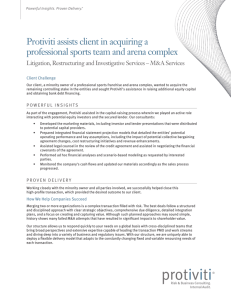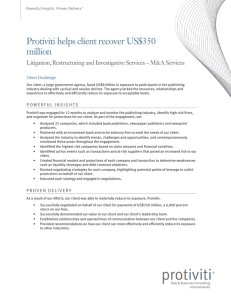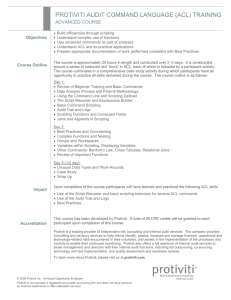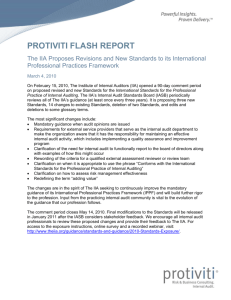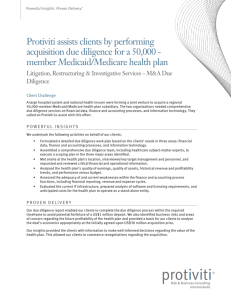The Bulletin - Improving Working Capital Management
advertisement
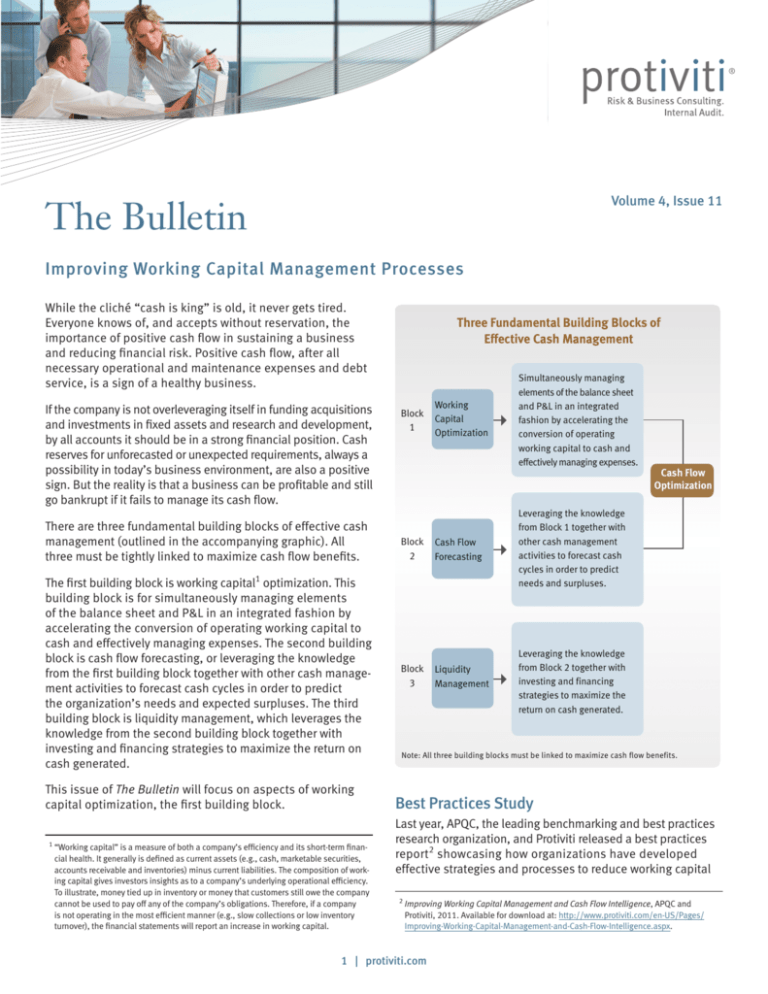
The Bulletin Volume 4, Issue 11 Improving Working Capital Management Processes While the cliché “cash is king” is old, it never gets tired. Everyone knows of, and accepts without reservation, the importance of positive cash flow in sustaining a business and reducing financial risk. Positive cash flow, after all necessary operational and maintenance expenses and debt service, is a sign of a healthy business. If the company is not overleveraging itself in funding acquisitions and investments in fixed assets and research and development, by all accounts it should be in a strong financial position. Cash reserves for unforecasted or unexpected requirements, always a possibility in today’s business environment, are also a positive sign. But the reality is that a business can be profitable and still go bankrupt if it fails to manage its cash flow. There are three fundamental building blocks of effective cash management (outlined in the accompanying graphic). All three must be tightly linked to maximize cash flow benefits. The first building block is working capital1 optimization. This building block is for simultaneously managing elements of the balance sheet and P&L in an integrated fashion by accelerating the conversion of operating working capital to cash and effectively managing expenses. The second building block is cash flow forecasting, or leveraging the knowledge from the first building block together with other cash management activities to forecast cash cycles in order to predict the organization’s needs and expected surpluses. The third building block is liquidity management, which leverages the knowledge from the second building block together with investing and financing strategies to maximize the return on cash generated. This issue of The Bulletin will focus on aspects of working capital optimization, the first building block. 1 “ Working capital” is a measure of both a company’s efficiency and its short-term financial health. It generally is defined as current assets (e.g., cash, marketable securities, accounts receivable and inventories) minus current liabilities. The composition of working capital gives investors insights as to a company’s underlying operational efficiency. To illustrate, money tied up in inventory or money that customers still owe the company cannot be used to pay off any of the company’s obligations. Therefore, if a company is not operating in the most efficient manner (e.g., slow collections or low inventory turnover), the financial statements will report an increase in working capital. Three Fundamental Building Blocks of Effective Cash Management Block 1 Block 2 Block 3 Working Capital Optimization Simultaneously managing elements of the balance sheet and P&L in an integrated fashion by accelerating the conversion of operating working capital to cash and effectively managing expenses. Cash Flow Forecasting Leveraging the knowledge from Block 1 together with other cash management activities to forecast cash cycles in order to predict needs and surpluses. Liquidity Management Leveraging the knowledge from Block 2 together with investing and financing strategies to maximize the return on cash generated. Cash Flow Optimization Note: All three building blocks must be linked to maximize cash flow benefits. Best Practices Study Last year, APQC, the leading benchmarking and best practices research organization, and Protiviti released a best practices report2 showcasing how organizations have developed effective strategies and processes to reduce working capital 2 Improving Working Capital Management and Cash Flow Intelligence, APQC and Protiviti, 2011. Available for download at: http://www.protiviti.com/en-US/Pages/ Improving-Working-Capital-Management-and-Cash-Flow-Intelligence.aspx. 1 | protiviti.com requirements and optimize cash used to fund operations. The report identifies 14 key best-practice findings and features the exceptional performance and approaches around working capital management (WCM) of three outstanding companies – a FORTUNE 500 consumer products company, a FORTUNE 500 packaging company and a large online retailer – providing specific examples of the best practices in action. According to a separate APQC survey involving senior finance executives at 355 large organizations, improving WCM is a goal CFOs are pursuing continuously. With the financial crisis still a vivid memory, the study noted: [T]he effort to raise liquidity during the recession delivered some astonishing “lessons learned.” The most compelling is this: Strong disciplines in working capital management lead to strong disciplines in operations – and that is what drives significant gains in resource productivity and, by extension, [profitable] growth. Beyond that, after spending tremendous effort to raise cash levels – and learning what works and what doesn’t when it comes to driving meaningful gains in process performance – CFOs tell us it would be a folly to let bad habits slide back in. Indeed, while the financial crisis energized the focus on managing cash flow, the question today centers on optimizing working capital. The best practices offered by the APQC/ Protiviti study provide valuable insights in this regard and are summarized below using four broad categories. Vision and Strategy for Improving WCM Because money tied up in accounts receivable or inventory has an associated cost of capital, WCM has a bottom-line impact. If an organization is able to reduce the level of working capital required to support its ongoing operations, the resulting cash savings can be channeled to alternative purposes. The best-practice organizations examined in the study found quantifiable economic benefits from improving their operating processes in ways that reduced investment in working capital. To illustrate, four of the findings in the APQC/ Protiviti study relate to the tight linkage of implementing operational discipline to improve WCM to the achievement of strategic goals: 1. The primary driver for working capital improvement at best-practice organizations is to align overall operational processes with stated strategic intent. 2. Executive-level support for and involvement in working capital optimization are prerequisites for reducing the amount of cash invested in operations. 3. Best-practice organizations centralize and standardize financial transaction processing to drive maximum efficiency and draw meaningful insights out of underlying data. 4. Best-practice organizations take a cross-functional approach to working capital accountability and continuous improvement of receivables and payables processes. Examples of Key Questions to Ask • • • • • • • • • • • • • • How reliable is our cash flow forecasting? Will we have access to our lines of credit, if needed? Should our investment strategy change? Will we be able to collect our receivables? Are we adjusting inventory levels based on reliable leading indicators? Should we adjust our capital spending and major maintenance plans? Do we have assets we should sell? Is reporting available to monitor performance effectively? Do we have any broken processes? Is customer demand changing? What is the financial condition of our key suppliers? Can we source more effectively to reduce costs? Are we exposed to significant supply disruptions? Are any of our major customers experiencing financial issues? In best-practice organizations, working capital improvements are driven by customer-centric strategies. All three organizations featured in the APQC/Protiviti study have centralized functions and standardized systems that improve the quality of information to manage working capital effectively and maintain a customer service mentality. The organizations focus on daily collection efforts through dedicated staff in functions such as credit and customer service and offshore routine transactions through either internal (captive) or external (outsourcing) delivery models. They also found strategic benefits to improving backend finance operations. Although WCM cannot be limited to a single function, organizations often struggle to break down barriers that prevent functions from working together on process improvement. Best-practice organizations succeed in taking a cross-functional approach to establishing accountability. They also have successfully instilled collaborative cultures, typically involving the sales, procurement, accounts payable, supply chain/operations, treasury and finance functions. In summary, a successful WCM approach begins with the creation of an overall strategy and vision, which in turn drives policy. Once a WCM strategy is in place, executives should ensure operational processes align with strategic intent through effective communication and change management. Designated process champions and change agents are needed to build the necessary cross-functional collaboration and stakeholder management and sustain the focus on 2 | protiviti.com change management. Ultimately, the companies that are successful in driving lasting change are those that effectively drive working capital into the mindset and culture of everyday decision-making, rather than applying a project focus for short-term gains. Analytics and Measures to Enable Better WCM While all of the APQC/Protiviti study’s findings are important, analytics and measures warrant the most attention. The identification of relevant data, drivers and measures to enable effective decision-making represents the core purpose of managing working capital. Four findings relate to this vital area: 5. Best-practice organizations use data from an enterprise resource planning (ERP) system to inform daily credit and collection units. 6. Best-practice organizations conduct real-time analysis of cash flow drivers to ensure reliable forecasts and optimize spare cash. 7. Best-practice organizations measure, analyze and advise operating units on how to increase the return on working capital invested in operations. 8. Best-practice organizations design custom measures of working capital that are relevant to their business models. Simply stated, best-practice organizations measure performance among their functions, look for opportunities to improve processes, and educate employees on their roles in WCM. Metrics, measures and monitoring are fundamental to the change process. Sample working capital benchmarks include: • • • • • • • • Return on Capital Working Capital as Percent of Sales Days Sales Outstanding (e.g., BPDSO [Best Possible DSO], ADD [Average Days Deficient] and DBT [Days Beyond Terms]) Percent Past Due (e.g., to monitor the level of past-due invoices) Invoice Error Rate Days Inventory Outstanding/Inventory Turns Days Payable Outstanding (e.g., Aged Unmatched Invoices) Procurement Card Percentage of Spend With respect to Finding (6) in the study, many organizations confine their cash flow forecasting routines to the annual planning process, failing to cascade actual cash flow patterns that could be extracted and analyzed from shorter-term views (e.g., daily, weekly, monthly) of financial performance. This limited approach misses the opportunity for early and predictive diagnosis of potential problems and ultimate financial outcomes. Best-practice organizations adjust forecasts in real time based on monthly meetings with functions such as treasury, financial planning and analysis, and accounting to compare and compile financial data (forecasted cash inflows and outflows versus actual, such as free cash flow per unit sold). Forecasts are then adjusted accordingly based on this review. The APQC/Protiviti study identified seven building blocks to measuring and managing working capital successfully using analytics and metrics: • • • • • • • Define metrics relevant to the organization Follow a timely reporting schedule Establish accountability for results Undertake a cross-functional perspective Provide frequent summaries for executives Automate systems for reporting and analytics Use benchmarks for process performance These building blocks drive quality into working capital processes and begin with a focus on defining metrics. The best-practice organizations start small, enabling them to measure the right value drivers and then act on the results to demonstrate success before expanding their analytics efforts. The seven building blocks offer valuable guidance to getting started. Performance Management Principles and Measuring Process Improvement While linking operational discipline around improving WCM to the achievement of strategic goals and implementing metrics, measures and monitoring are both important, there must also be a strong commitment to continuous process improvement. There are four findings relating to instilling this commitment: 9. Best-practice organizations apply quality and productivity tools to process improvement efforts in finance. 10. Best-practice organizations leverage change management principles and practices in finance. 11. Best-practice organizations identify and resolve data discrepancies on the front end of the process. 12. Best-practice organizations manage working capital risk. One of the companies highlighted in the study applies a “Lean Six Sigma Model” to its back-office finance and administrative processes, helping it to reduce waste and improve the performance of critical customer requirements that affect its working capital. A key component of this model is the use of Kaizen events, enabling cross-functional teams to meet in one location to map out a business process in an effort to “lean it out” and break down silos by allowing team members to understand the total process and determine how to improve it by focusing, simplifying and automating it. Best-practice organizations apply core change management principles – such as regular 3 | protiviti.com communication and training – to their efforts to improve WCM and cash flow intelligence. Regarding resolving exceptions up front in its interactions with suppliers, the best-practice online retailer featured in the study curtails three-way match discrepancies and failures through four steps: • • • • Automate communications to expedite the early resolution of purchasing, receiving and invoicing exceptions. Enable buyers to make more educated decisions and have access to up-to-date information regarding purchases. Introduce EDI transactions3 to improve communications between the buyer and the vendor regarding such transactions as purchase order creation, acknowledgements, change orders, advanced shipping notices and invoicing. Improve roles, access and security controls for the vendor portal, allowing vendors and sales representatives to view their sales volumes, accounts payable invoices and exceptions data so they can resolve exceptions in a timely manner. Building in quality early in the process synchronizes company and vendor systems, facilitating a more efficient procure-topay cycle. With respect to the above example, supply chain issues surfaced in the accounts payable department during a review of key WCM metrics. The impact was a reduction in the quality of the customer experience through delays in getting products “sellable” on the Web. In the past, the organization didn’t realize it had a problem until the invoice was due and, in some cases, when the invoice was past due. These issues were also making it difficult to effectively forecast and manage cash flow. Since the goal is to get the product to the shelves, sell it as quickly as possible and provide timely payments to vendors, up-front resolutions with vendors are essential. The bottom-line benefits: Purchasing and receiving exceptions were reduced by 75 percent and invoice reconciliation improved by 85 percent, which improved the company’s ability to leverage payment discounts. With respect to managing risk, best-practice organizations leverage their working capital metrics to anticipate and manage supply chain and inventory risks. They conduct regular working capital reviews to bring together key executives and managers with working capital operating authority to discuss the company’s performance across multiple dimensions. These reviews confirm progress on working capital improvement projects, update cash flow projections feeding into treasury’s cash management strategies, and drive periodic evaluations of the risk balance between exceptional customer service and 3 lectronic data interchange, or EDI, is the structured transmission of electronic E documents or business data between one computer system and another according to agreed message standards and without human intervention. While EDI enables organizations to communicate by electronic means, it can be used to replace paper documents and transform transaction cycles. For example, two trading partners can replace bills of lading and checks with appropriate EDI messages. EDI documents typically contain the same information that would be found in a paper document used to effect the same transaction. inventory investment. To illustrate, the consumer products best-practice organization treats working capital and cash flow intelligence as key risk management tools by using information to identify issues (e.g., customer payment patterns that signal likely problems). These examples demonstrate the benefits of a disciplined and continuous approach to WCM process improvement. If an organization identifies invoice error rate as a key lever of WCM improvement with the order-to-cash cycle, then it can reduce the error rate by standardizing and consolidating invoicing processes, automating manual processes, and/or more fully utilizing existing ERP system functionality, as well as improving the data integrity of customer master files. IT Strategy and Application Each of the three best-practice organizations in the APQC/ Protiviti study use supporting technology to increase the efficiency of their WCM processes. The two findings in this regard are: 13. Best-practice organizations embrace the concept of selfservice to drive efficiency. 14. Best-practice organizations conduct transactions electronically whenever possible and work with vendors (and customers) so they can do the same. Often, the necessary tools to implement these practices require minimal IT support and allow finance, other staff and vendors to access the information they need when they need it. For example, the global packaging best-practice organization uses an SAP BusinessObjects report-writing tool that allows finance staff to generate reports in real time without IT staff intervention. These reports are populated by data derived from the organization’s ERP system using its global SAP implementation. The consumer products best-practice company uses a web portal to indicate to vendors which invoices are available for early payment; vendors then select options that appeal to them. In addition, the company’s treasury function leverages self-service tools to reduce workload and increase cash management efficiency by detailing current-day cash positions through SAP, automating delivery of electronic bank statements five times a day, and automating cash flow postings to its general ledger. The online retailer best-practice organization has automated WCM through implementing an Oracle workflow engine and internally developed applications to enable communications among facilities, vendors, employees and staff members as the business grows. This capability facilitates effective management and resolution of workflow action items in a self-service delivery mode. An ERP system can significantly improve an organization’s ability to accelerate cash inflow. Standardized ERP systems eliminate the challenges that come with individual regions being on disparate systems, as data can be measured globally and consistently. Best-practice organizations utilize ERP 4 | protiviti.com systems to make day-to-day decisions about customers and credit, and accumulate information globally to provide a crossfunctional view of customers’ histories with insight into their payment habits. A Call to Action Based on the best-practice findings, there are four key calls to action for executives and managers intent on strengthening their company’s working capital management capabilities: EDI and “e-invoice” management have become commonplace among finance functions. The three best-practice organizations highlighted in the APQC/Protiviti study work to maximize their use of these tools in a way that benefits everyone involved. For example, the global packaging company streamlines and simplifies its work with vendors through implementing an evaluated receipt settlement (ERS), which eliminates paper invoices and reduces its matching efforts from three pieces to two. The major benefits of ERS include invoice variance prevention, the elimination of non-value-added work (e.g., tasks associated with reconciliation activities) and the opportunity cost of errorprone cash conversion. Sixty percent of the organization’s North American customer receipts are based on the ERS two-way match, with the remaining vendors soon to be paid electronically. Currently, 70 percent of all payments worldwide are made electronically through EDI. These activities clearly demonstrate the value the company places on its vendor relationships. 1. Align working capital management processes with corporate strategy, centralize financial transaction processing, cultivate cross-functional engagement and provide sufficient executive-level support. 2. Identify relevant drivers of working capital management value and risks, and then use these drivers to develop metrics that complement the unique aspects of the company’s business model. 3. Commit to improving working capital management processes continuously through cross-functional engagement (e.g., ensure all employees understand how their activities influence working capital, deploy benchmarking, provide executivelevel support). At the consumer products best-practice organization, 73 percent of cash transactions (including invoicing and payments) are electronic. The organization’s working capital processes tend to be automated and digital, with widespread vendor involvement. 4. Once working capital management strategy and processes are in place, use enabling technology to increase efficiency and support related process improvements. Getting Started Based on the best-practice findings, the APQC/Protiviti report outlines four key calls to action for executives and managers intent on strengthening their company’s WCM capabilities (see “A Call to Action” at right). Culled from the best-practice WCM programs, the “Call to Action” raises an important question: From a practical standpoint, how do management teams intent on developing WCM best practices get started? The APQC/Protiviti study recommends a four-step proactive approach to improve process capabilities, cut costs and recover potentially lost funds through improving WCM: • • Key Indicators Confirming the Need for an Assessment of Financial and Operational Practices • • • • • • • • • Liquidity constraints Excessive, obsolete or growing inventories Inadequate forecasting and demand planning Recent credit rating downgrade Aging receivables Payables leakage (e.g., duplicate payments, etc.) Poor working capital ratios Fragmented spend Workforce layoffs/targeted facility closings • • Uncover sources of uncertainty – Begin by determining what new and existing risks the company faces, and determine how those risks will impact demands on working capital. Conduct a “working capital diagnostic” – Assess working capital by analyzing data about the company’s operations and capabilities and benchmarking against peers. (See list of key indicators at left confirming the need to assess financial and operating practices.) Reassess working capital policy – Define working capital policy in the context of the organization’s business model and risk tolerance to determine whether current risks allow for an aggressive, moderate or conservative policy. Optimize working capital – Exploit opportunities to optimize working capital existing in areas such as cash and marketable securities, sourcing, procurement, accounts receivable, accounts payable and inventory. Companies with the most advanced WCM capabilities treat the discipline of WCM as an opportunity to manage performance and risks in a way that supports the execution of strategic plans. As the examples previously illustrated indicate, best 5 | protiviti.com practices enable financial and operating managers to work together in delivering valuable contributions to their organizations that impact both cash flow and the bottom line. Summary As the APQC/Protiviti report shows, CFOs, controllers, treasurers and other managers who treat WCM as a strategic priority, and as an ongoing business process that integrates with performance management and risk management processes, can free up cash to fund strategic investments while delivering higher-than-expected results to shareholders. One of the lessons of the financial crisis is the importance of being prepared for recessionary times when companies can face major challenges in funding business operations, particularly when there is reduced access to short-term credit. When these events occur, more companies decide to cut discretionary and capital spending and also consider capacity reductions, store and facility closings, and layoffs. Because these decisions come with a heavy price, companies should keep in mind that solutions to improve working capital are available that do not require access to credit or other funding. The 14 best practices identified in the APQC/Protiviti study provide a road map for taking a closer look at how companies manage their working capital and determine where they can achieve greater efficiencies and cost savings. Want to Know More? APQC, the leading benchmarking and best practices research organization, and Protiviti collaborated to publish a best practices report to showcase how three premier organizations have developed effective strategies and processes for reducing working capital requirements and optimizing cash used to fund operations. The report illustrates how these companies drive continuous improvement in receivables and payables processes and deploy innovations in areas such as supply chain finance and cash flow analytics. The organizations examined in this study clearly consider effective WCM as a necessary component of their growth and profitability. By turning to their working capital as a source of funds, each organization uses approaches tailored to the nature of their respective business models and operations to reap the benefits from efficient, streamlined WCM. The best practices report is available on the Protiviti website at http://www.protiviti.com/en-US/Pages/Improving-WorkingCapital-Management-and-Cash-Flow-Intelligence.aspx. In addition, printed copies are available upon request. Protiviti is not licensed or registered as a public accounting firm and does not issue opinions on financial statements or offer attestation services. © 2012 Protiviti Inc. An Equal Opportunity Employer PRO-0512
